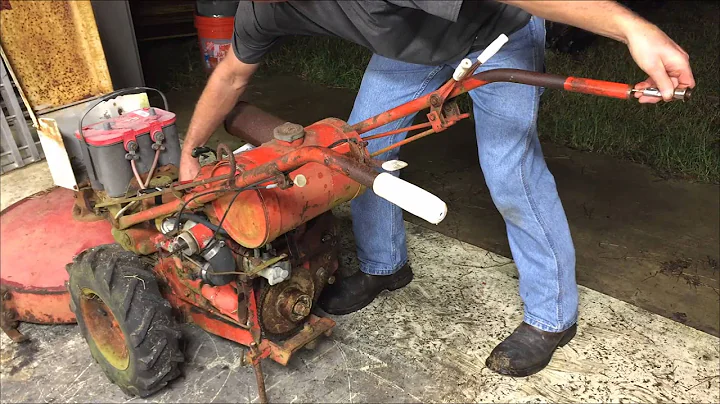Mastering Node Controller Programming for Efficient Irrigation
Table of Contents
- Introduction
- Benefits of the Node Controller
- Features of the Node Controller
- Programming the Current Date and Time
- Setting the Start Times
- Assigning Run Times to Stations
- Configuring Days to Water
- Creating Separate Programs
- Using Seasonal Adjustment
- Putting the Controller into Off Mode
- Manual Control of Stations
🚀 Introduction
In this article, we will explore how to program the Node Controller, a battery-operated controller that offers the same programming capabilities as an AC controller. The Node Controller is a viable solution for areas where access to electricity is a challenge. We will discuss its benefits, features, and step-by-step instructions for programming the controller.
🌟 Benefits of the Node Controller
The Node Controller provides several advantages for users, including:
- Ability to install in areas without access to electricity
- Battery-operated for convenience and flexibility
- Same programming capabilities as AC controllers
- Suitable for both residential and commercial applications
- Easy to program and operate
Despite being battery-operated, the Node Controller can perform the same functions as AC controllers, allowing users to overcome challenges related to electricity availability.
🔍 Features of the Node Controller
Before we dive into the programming process, let's explore some of the key features of the Node Controller:
- Battery Operation: The Node Controller runs on batteries, eliminating the need for electricity.
- DC Latching Solenoids: The controller requires the use of DC latching solenoids, which are included with the Node 100 model. For other Node models, the solenoids need to be purchased separately.
- Multiple Buttons: The controller has six buttons - plus, minus, left arrow, right arrow, center button, and program button. These buttons are used to navigate through different settings and make adjustments.
- Blank Screen: When not in use, the controller displays a blank screen or enters sleep mode. Pressing any button activates the screen.
- Start Times: Programs in the Node Controller can have up to four start times, allowing for flexible scheduling.
- Run Times: Each station in the program can be assigned a specific run time, ensuring efficient watering.
- Days to Water: Users can choose specific days, odd or even days, or interval mode to determine the watering schedule.
- Seasonal Adjustment: The Node Controller offers a seasonal adjustment feature, allowing users to modify run times according to environmental conditions.
- Off Mode: The controller can be placed in the off mode, disabling all watering operations until reactivated.
- Manual Control: The Node Controller also provides manual control of stations, allowing users to start or stop watering as needed.
Now that we understand the benefits and features of the Node Controller, let's proceed with the programming process.
📅 Programming the Current Date and Time
To begin programming the Node Controller, the first step is to set the current date and time. This ensures accurate scheduling of watering operations. Follow these steps:
- Press the center button to activate the screen.
- Use the right arrow to scroll through the available choices, including year, month, day, and AM/PM mode.
- Use the plus or minus buttons to adjust the flashing values.
- Use the right arrow to navigate to the hour and minute settings, making adjustments as necessary.
- Return to the year setting by pressing the right arrow.
- Press the center button to advance to the next screen.
- Continue scrolling through the screens until you reach the home screen, which displays the current time of day.
By correctly setting the current date and time, the Node Controller will be ready to execute watering schedules accurately.
⏱️ Setting the Start Times
The Node Controller allows users to program up to four start times for each program. Start times determine when watering operations begin. To set the start times, follow these steps:
- Press the center button to navigate to the second feature, which displays the start time for Program A.
- Use the plus button to increase the start time and the minus button to decrease it.
- Navigate to the second, third, or fourth start time by using the right arrow.
- To delete a start time, select the desired start time and use the plus button to set it to "Off."
- Press the center button to return to the home screen.
It's important to note that the start times are specific to the program and not the individual stations. By configuring the start times, users can ensure that watering operations begin at the desired times.
⌛ Assigning Run Times to Stations
Each station in the Node Controller can be assigned a specific run time, ensuring that plants receive the appropriate amount of water. Follow these steps to assign run times to the stations:
- Scroll through the screens using the center button until you reach the station run time for Program A.
- Use the plus button to set the run time for each station. Only assign run times to stations within the same program that have the same watering day requirements.
- Use the right arrow to navigate to the next station and set its run time. Repeat this step for all stations within the program.
- After completing the assignments, scroll through the screens to the off screen and return to the home screen.
By assigning run times to stations, users can ensure that each plant or zone receives the appropriate amount of water based on its requirements.
📅 Configuring Days to Water
The Node Controller provides flexibility in scheduling watering operations by allowing users to choose specific days, odd or even days, or interval mode. Follow these steps to configure the days to water:
- Use the center button to navigate to the water day feature.
- Use the right arrow to scroll through the days of the week. Use the plus button to select a watering day and the minus button to deselect it.
- To choose odd or even days, navigate to the "Odd" or "Even" option respectively and use the plus or minus button to select or deselect it.
- Users can also opt for interval mode by using the left arrow to navigate, selecting a specific number of days using the plus or minus button.
- Return to the home screen using the center button.
By configuring the days to water, users can set up personalized watering schedules tailored to their plants' needs.
💡 Creating Separate Programs
In some cases, users may require different watering schedules for various zones or stations. To accommodate this, the Node Controller allows users to create separate programs. Follow these steps to create separate programs:
- Use the center button to navigate to the start time setting for the desired program.
- Use the left arrow to go back to the start time 1 screen and press the program button once to switch to another program, such as Program B.
- Use the right arrow to navigate to the start time 1 for Program B and set the desired start time using the plus or minus button.
- Use the right arrow to move through the start times. If Program B does not require additional start times, leave them in the off position.
- Use the center button to proceed to the next settings, such as run times and days to water, for Program B.
- Repeat the process for each additional program as needed.
By creating separate programs, users can customize watering schedules based on the unique requirements of different zones or stations.
⛅ Using Seasonal Adjustment
To account for variations in environmental conditions, the Node Controller provides a seasonal adjustment feature. By adjusting the run times, users can optimize water usage. Follow these steps to use the seasonal adjustment:
- Press the center button to navigate through the screens until you reach the percentage setting.
- Use the plus button to set the desired percentage. Starting at 100% provides the original run times, while reducing it to 50% will cut all run times in half.
- Proceed to the off screen using the center button and return to the home screen.
The seasonal adjustment feature allows users to easily modify the run times for all stations in the controller based on changing environmental conditions.
❌ Putting the Controller into Off Mode
There may be instances when users want to temporarily disable watering operations. The Node Controller offers an off mode to achieve this. Follow these steps to put the controller into off mode:
- Scroll through the screens using the center button until you reach the off screen.
- Once "Off" is displayed, the controller will enter the rain off mode, disabling all watering operations until reactivated.
- To reactivate the controller, simply use the center button to navigate back to the home screen.
The off mode provides a convenient way to pause watering operations without the need to reprogram the entire controller.
👐 Manual Control of Stations
The Node Controller also supports manual control of stations, allowing users to start or stop watering operations as needed. Follow these steps to manually control stations:
- Hold down the right arrow button to enter the manual mode.
- Use the right arrow to navigate through the stations that need to be turned on.
- When the desired station is displayed, it will count down, and the zone icon will flash in the top-left corner.
- To turn off a station, use the center button to scroll through the screens until you reach the off screen.
- Return to the home screen using the center button.
Manual control of stations provides users with immediate control over watering operations, allowing for adjustments and troubleshooting when necessary.
🙋♂️ Frequently Asked Questions (FAQs)
Q: Can the Node Controller be used in residential applications?
A: Yes, the Node Controller is suitable for both residential and commercial applications.
Q: How many start times can be programmed in the Node Controller?
A: The Node Controller allows for up to four start times per program.
Q: Is it possible to program different run times for stations within the same program?
A: Yes, users can assign specific run times to different stations within the same program.
Q: Can the watering schedule be adjusted based on seasonal changes?
A: Yes, the Node Controller offers a seasonal adjustment feature to modify run times based on environmental conditions.
Q: Is it possible to manually control watering operations with the Node Controller?
A: Yes, the Node Controller supports manual control of stations, allowing users to start or stop watering operations as needed.
Q: Can the Node Controller operate without access to electricity?
A: Yes, the battery-operated Node Controller can be installed in areas where access to electricity is a challenge.
🌐 Resources
In this comprehensive guide, we have explored how to program the Node Controller, its features, and the step-by-step process for setting up watering schedules. By following these instructions, users can effectively utilize the Node Controller to automate and manage their irrigation systems. Remember to consult the official user manual for additional guidance and support from the manufacturer.







